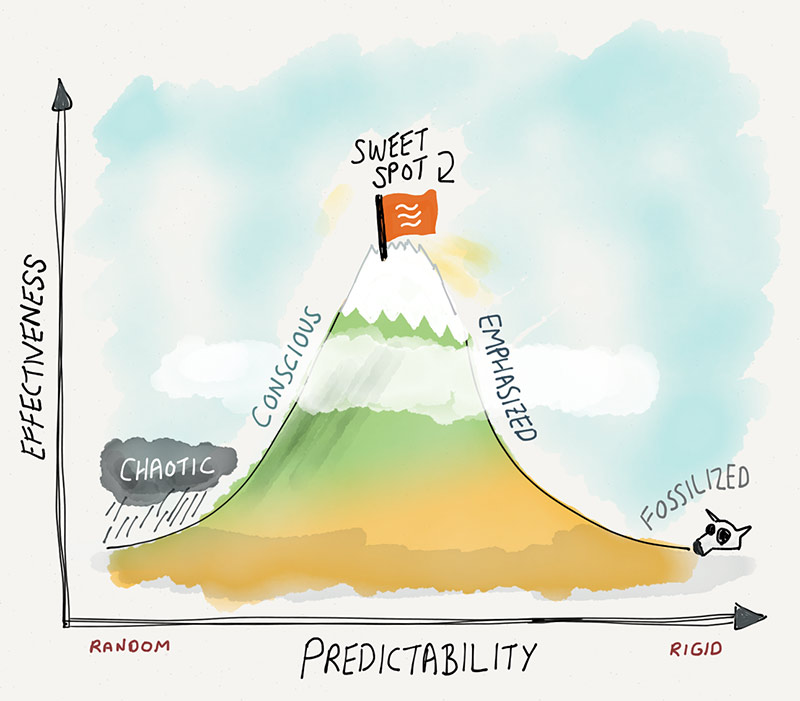I spend a lot of time working with project managers, and it’s something I love. I also manage a few projects each year. The New Year always presents a good opportunity for me to revisit not just what I’m doing but how I’m doing it. Michael Gerber, author of the book The eMyth, suggests that we need to work on our business and not just in our business. The trouble is, it’s easy to never look up from the task at hand. Instead we just work busily, trying to keep up with the rush of activities and communications streaming by.
I have a home in the Blue Ridge Mountains where I go to write. Recently a neighbor moved and left me a garage full of tools. It was a generous act, but I quickly found that my workshop was overwhelmed. Suddenly I had no room to do anything, and the problems started compounding. Tasks that had once been trivial were choked down to the point of being nearly impossible. Things backed up. My system of organization had plunged off of a cliff, and my productivity followed right behind it.
I ended up using my project management experience to organize my workshop and reclaimed some productivity and sanity. Here are three lessons to apply to organizing projects.
Lesson 1: Strive for simplicity
Antoine de Saint-Exupery famously pointed out that “perfection is achieved, not when there is nothing more to add, but when there is nothing left to take away.” In other words, the goal is to create elegant, clean, highly functional systems.
Too much or too little structure can be deadly to a project, paralyzing innovation and productivity. Too much organization cripples innovation. Too little creates a chaotic environment I refer to as “heroic effort.” The art is finding the sweet spot.
The sweet spot maximizes effectiveness by applying just the right amount of process.
One acquaintance organizes his workshop so that each tool has a white outline painted around it, to make it obvious where to return missing items. It looks like a miniature crime scene, and he keeps it cleaner than an operating room. As amazing as it is to see, I would argue that some organization efforts choke the productivity right out of the projects.
This is where I love the Agile philosophy of “barely sufficient.” How much organization should we have? The answer is “just enough.” There are plenty of people who want to plan and organize each project ad infinitum, but too much organization and planning can kill innovation and productivity.
Have we reached the sweet spot yet?
One of the best ways to know when you’ve reached the sweet spot of just enough process at work is by asking the team. Ask them what they think needs to happen for them to operate at peak performance. Ask them to rate the team’s performance on a scale. Ask open-ended questions such as “How could we do better?” Then listen! They’ll tell you.
2. Implement the sunset clause – every process has a lifespan
The problem with processes and systems is that they stubbornly cling to life long after they’ve served their purpose. A good process should make things easier, safer or better for the team; but at some point it will likely become someone’s job to make sure that the process is being followed. At that point the process becomes as tenacious as crabgrass.
In my workshop, my first activity was to take every single tool out of the environment. The junk that I had accumulated over time was piled right alongside the new cache of power tools. Then, one at a time, I inspected each item and either found a place for it, or set it aside to be donated or recycled. I probably got rid of 20% of the things in my workshop, and that made a terrific difference.
Applying the sunset clause
Every process needs to have a sunset clause. Use the New Year to review all of your team’s formalities, processes and systems and see what needs to be streamlined, reengineered or altogether retired. Think about the policies and systems you have in place on your project. Are the processes still serving the project or the organization, or has the project become servant to the process?
Years ago, I managed projects for a company that had been spun off from a regulated business. The amount of process that had been in place to implement software changes was overwhelming. Rather than accept it as it was, the team worked for a solid week just to streamline the process. Cutting through the red tape turbocharged the team.
Lesson 3: Continually improve: the principle of kaizen
I am a big believer in the principle of kaizen (continuous improvement). I rarely try to fix a complex problem in one fell swoop. Instead, I make a plan, take steps, and then (the most important element of kaizen) revisit the plan and execution simultaneously and make small adjustments. I try to do that regularly, which means systems aren’t rigid and static, but instead are alive and dynamic.
In my workshop, I began organizing each new and existing item according to its function; I quickly realized that this wasn’t going to use the space effectively. Rather than blindly sticking to my plan, I had to back up, remove quite a few things, and adjust. By hanging some of the larger, heavier items from the ceiling (regardless of function), it would free up room and greatly improved the flow.
Practicing kaizen at work
For your projects, this means that the way the team plans and the way they execute has to be measured and reviewed regularly. Do you track actual performance against ranged estimates? Simply recording this information and reviewing it with the team can often have a big impact. What gets measured, gets improved.
The point of kaizen is that you remain aware of what you’re doing and how and why you’re doing it. It requires you to be thoughtful about each step. An autopilot mentality is not rewarded.
Organizing projects and improving processes is a process unto itself. By rightsizing your systems, you can have a dramatic impact on increased productivity, team morale and overall quality. It’s hard for many project managers to embrace, but the way things are done can be as important as the outcomes. Simplifying and streamlining can truly work wonders – for both workshops and projects.
Do you have a way of organizing projects to share with us? Drop it off in comments, we want to hear from you!
Andy Crowe is the CEO and founder of Velociteach, and author of Alpha Project Managers: What the Top 2% Know That Everyone Else Does Not; The PMP Exam: How to Pass on Your First Try, and the The PMI-ACP Exam: How to Pass on Your First Try. His books have sold over 150,000 copies worldwide. Velociteach was PMI’s provider of the year in 2012 and was recognized as one of 2013’s top 100 small businesses in the USA by the US Chamber of Commerce. He is a PMP, a PgMP, and a Six Sigma Black Belt, and he lives in Kennesaw, GA.
 Schedule a demo of LiquidPlanner with a product expert today
Schedule a demo of LiquidPlanner with a product expert today









